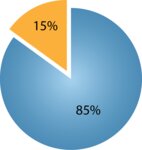


Just as the Halloween candy is finally eaten up, here comes Thanksgiving, followed on its heels by the December celebrations (Christmas, Chanukah, Kwanzaa, and New Year’s Eve), of which deliciousness is a big part.
It’s less than a week past Thanksgiving and mine, like most folks’ celebrations, was RICH. Think gravy (FAT) and desserts (SUGAR), as the standouts for richness. I was left with a good share of leftovers in the refrigerator and just finished off the desserts. Talk about overindulgence in SUGAR, my favorite friend and temptress!
My son and his girlfriend Lil dropped by after their celebration, feeling overindulged in FAT. My son, the gourmet cook, loves to cook with abundant and creative fat, which makes food especially luscious. They were delighted that I had prepared a simple lemon turkey soup with leeks, zucchini, and rice served with fresh vegetables on the side to dip in my brother’s homemade hummus. Lil’s response, “Fresh veggies at last– my dream come true!” She speaks about love of the 85% …keep reading.
Definition: Foodie (from the Cambridge Dictionary) – a person who loves food and is very interested in different types of food.
Foodie is a new-ish term for a personal characteristic that is not new. My experience is that most people are foodies, though, there are a few who don’t care what they eat or about eating. Even one of my brothers, a strict vegan, is a foodie. You can’t believe what those vegans come up with for delicious and healthy. Many non-foodies have lost their appetites because of a variety of serious health conditions. Being a non-foodie may not be a good thing at all.
Eating is both delicious and pleasurable as well as life-force sustaining. Sharing food with others is an important social connection for health as well. Feeding people is an act of love for many of us, this author included!
I’ve not written about nutrition until now for a variety of reasons. First, the field is rife with controversy. Second, though I know a great deal about nutrition, I still do not practice the best behaviors myself. What drives appetite and causes obesity and being overweight? That is a topic for another column and a fascinating cutting-edge one at that. Third is that nutrition is complex, like every topic in health and medicine.
Still, I’d like to tackle, in broad brushstrokes, how it is possible to plan and commit to healthy eating at the most tempting time of the year. If we do it now, some good habits may become second nature after the holidays. It takes time to develop new habits, so why not start at the toughest time?
I perused a 164-page document called: Dietary Guidelines for Americans 202-2025 available at www.dietaryguidelines.gov in preparation for this column. It is thorough and elegantly presented for professionals through a collaboration between the US Department of Agriculture and Health and Human Services. I share some highlights with hopes that they will assist you in making your holiday eating plan and resolutions.
This guide refers to 85 as the percentage of calories eaten in a day needed to meet the nutrient-dense food group requirement. Yeah, Lil! Nutrient-dense foods are those foods that are ‘good for you.’ You know what they are: vegetables, fruits, dairy, ‘good’ oils, grains, and protein sources (from vegetable = legumes to animal = eggs, meat, seafood).
The remaining 15 percent is left for ‘other uses,’ or what I call ‘eater’s choice.’ This percentage might include several nutrient-poor edibles or drinks also known as less healthy choices. You know these too: sugar, saturated fats, sodium (i.e., salt), and alcohol.
What I like about this 85-15 guide is that there are no musts or don’ts. The idea is to weigh heavily on the former and lighter with moderation on the latter.
Alcohol is now known to cause adverse consequences when imbibed in more than the ‘considered safe’ amounts, which lately have been demonstrated to be much lower than in the past. ‘Safe’ alcohol consumption is this: less than or equal to 2 drinks a day for men and 1 for women. One drink is equivalent to 12 oz of beer, 5 oz of wine, or 1.5 oz of 80-proof distilled spirits.
Here are some things to consider in PREPARATION for holiday eating:
Preparation for the challenges ahead and a commitment to do your best in following your plan will help you be a better, more discriminating, and healthy eater. Preparation helps you identify how you are most vulnerable and what you can do about it. Only you need to know your plan…and follow it to the best of your ability. Temptations are temptations. Perfection is likely not attainable!
Here are a few ideas to start that have helped me and others:
Starting and practicing a healthy eating plan now in the month ahead may help you sustain the good habits you acquire after the holidays and beyond.
For those who struggle with food insecurity and financial challenges to buy healthy food, check out if you or a loved one might be eligible for the SNAP program.
https://www.fns.usda.gov/snap/supplemental-nutrition-assistance-program
…and an important corollary to health over the holidays and winter ahead…
Exercise is the other half of this healthy habit equation. But more on that topic in a future column.
Comments
No comments on this item Please log in to comment by clicking here